New York‘s diverse climate is a dream for gardening enthusiasts looking to spruce up their outdoor spaces. If you’re interested in planting perennial flowers in your New York garden that will return year after year, offering a consistent display of blooms, this article is for you.
We’ll walk you through some of the most resilient and beautiful perennial flowers perfectly suited for New York’s hardiness zone 3-7. Get ready to add a splash of color and life to your garden with our top picks for perennial blooms!
1. Golden Alexander (Zizia aurea)
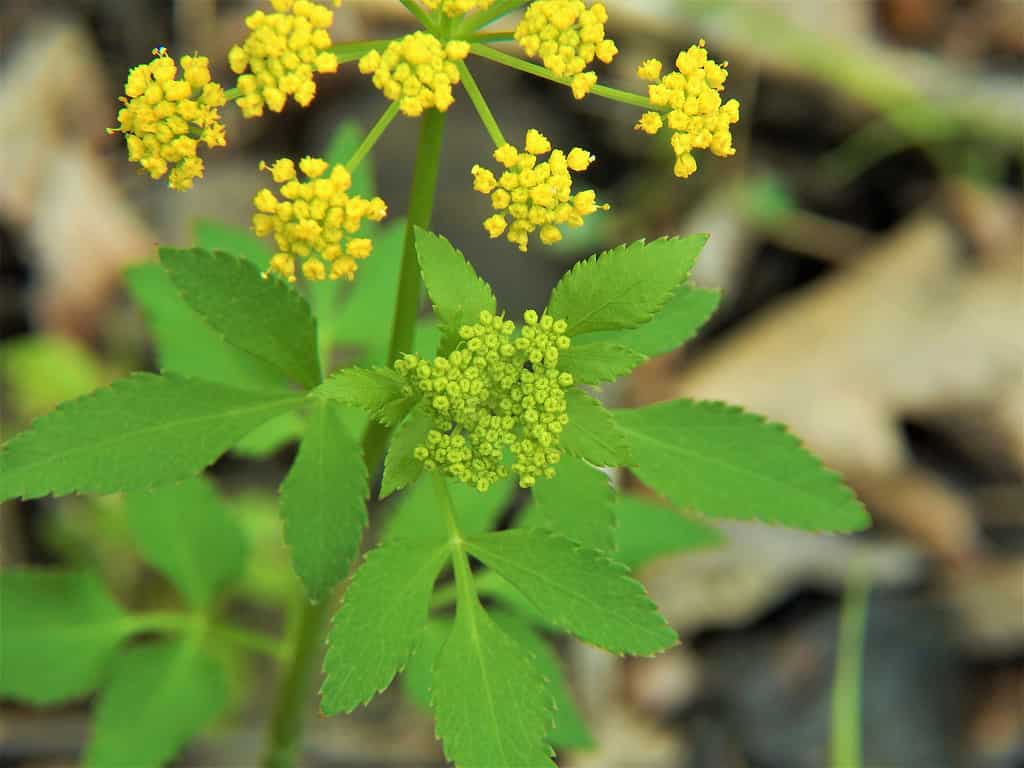
In early spring, golden Alexander will start to bloom with these small yellow flower buds.
©ErikAgar/iStock via Getty Images
Golden Alexanders is a perennial plant that doesn’t stick around for long (around 5 years). However, it offers big clusters of small, bright yellow blooms. These appear between late spring and early summer, making the plant a wonderful option for early-season color in your garden. Not only do they look pretty, but they also serve as an excellent source of nectar for pollinators like bees and butterflies.
This plant can easily spread through seeds and, under the right conditions, can expand to cover a large area.
Golden Alexanders can grow surprisingly tall, with some reaching over 3 feet and a width of 18 to 24 inches. For the best results, plant it in a spot that gets either full sun or partial shade. The soil should be moderately moist and well-draining.
2. Adam’s Needle (Yucca filamentosa)
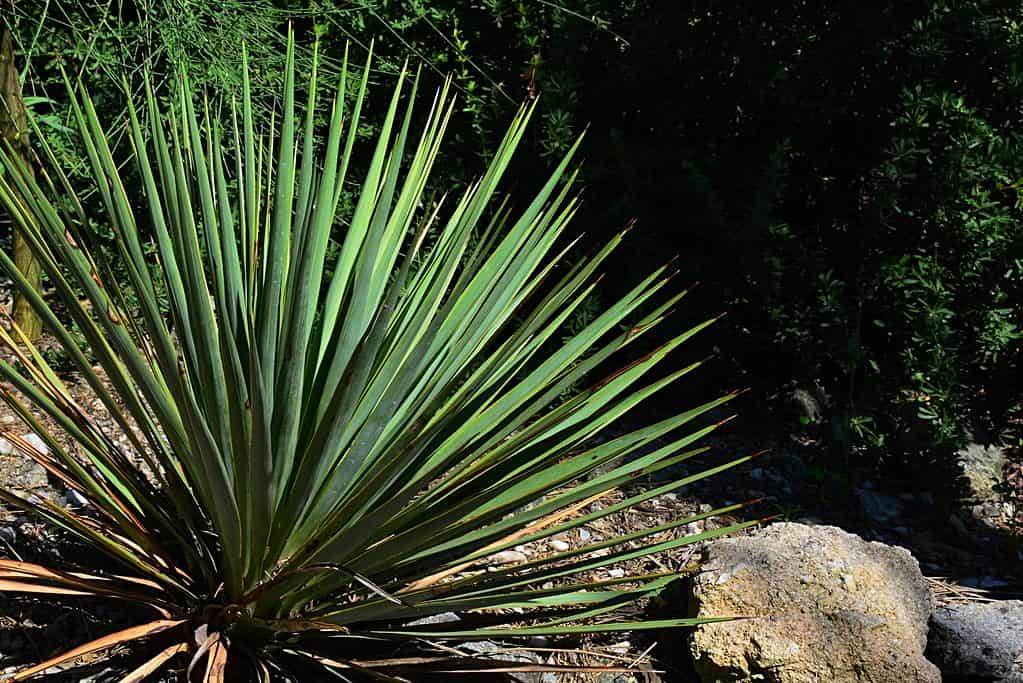
For most of the year, Adam’s needle is a sharp cactus-like plant, but once per year, in the early summer, a massive bloom shoots out of the top of the plant.
©ZayacSK/Shutterstock.com
Adam’s needle is a New York native perennial flower that’s quite distinct in appearance. Its base consists of sturdy, sharp-tipped leaves that are deep green and have curly threads along the edges. During the early to middle of the summer, the plant sprouts a tall stalk, reaching heights between 5 and 8 feet. This stalk bears drooping clusters of creamy-white, bell-like flowers that are roughly 2.5 inches in length.
It’s important to note that this plant is poisonous to dogs, cats, and horses. So, avoid planting this if you have curious pets that might try to eat it.
The leaves of Adam’s needle collectively create a mound of foliage, generally reaching dimensions of 2 to 3 feet in both height and width. For optimal growth, plant it in a sunny location where the soil is well-drained and ranges from dry to moderately moist.
3. Long-Spurred Violet (Viola rostrata)

Long-spurred violet is a beautiful purple flower that thrives in New York.
©Maurizio Photo/Shutterstock.com
Originating from the eastern regions of North America, long-spurred violet is a small perennial that features heart-shaped leaves with serrated edges and a dark green hue. From the middle of spring until early summer, you can expect to see striking lilac-purple blossoms. These flowers come with an unusually long nectar tube and are marked with deep violet lines on their upper petals. The lower petals also show similar dark violet patterns, and notably, the two side petals lack any “beard.”
If you allow the plant to produce and drop seeds, you’ll likely find new little sprouts popping up in subsequent years.
Long-spurred violet is a relatively small plant that only reaches a height of 6 to 8 inches and spreads out to a width of 4 to 6 inches. Plant it in an area that receives partial to full shade. The soil should be rich in organic material, adequately moist, and well-draining.
4. Canadian Violet (Viola canadensis)

This white and yellow perennial flower is the Canadian violet and thrives in New York gardens.
©Dana Henry Photography/Shutterstock.com
The Canadian violet is a perennial that forms clusters and offers up aromatic blooms with five white petals, which may sometimes exhibit a purple hue on the back side. Notably, the base of these petals is a distinct yellow color, and the bottom petals display purple lines that help guide pollinators to the nectar. Depending on where you are, these flowers appear from summer through fall.
Regarding its size, the Canadian violet typically grows to a height and width of 12 to 18 inches. One thing to note is that this plant is prolific when it comes to self-seeding. In some cases, it may spread quite rapidly, leading to a thick gathering of plants.
For optimal growth, this violet prefers a location with partial shade and thrives in nutrient-rich and well-draining soil while also maintaining some moisture.
5. New York Ironweed (Vernonia noveboracensis)
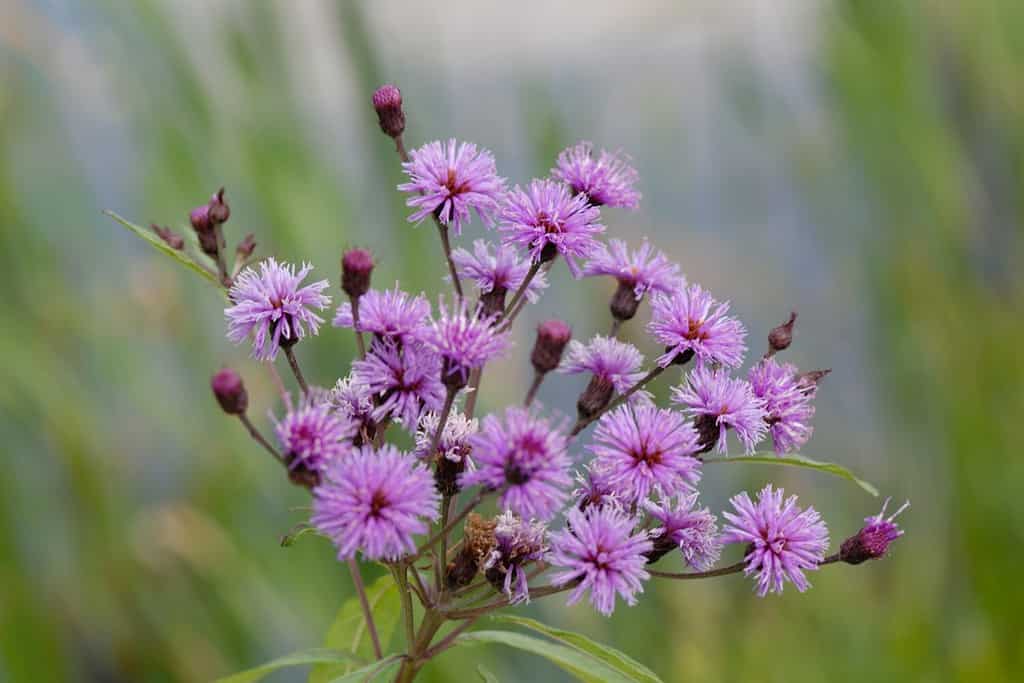
A unique perennial flower is the New York ironweed, with each flower cluster containing up to 50 petals!
©Walter Erhardt/Shutterstock.com
The New York ironweed is a hardy perennial that offers deep purple flowers in clustered arrangements. Appearing in the late summer and continuing into early autumn, each cluster can contain between 30 to 50 tiny, fine-petaled blooms. The flowers, set atop strong, vertical stems, and attract butterflies. Additionally, they are accompanied by lance-shaped leaves that are a rich shade of green.
Because of its height and slender shape, this plant works well at the rear of flower borders or in more confined areas, and it’s also a good fit for native meadow gardens.
Expect this perennial to reach heights of 4 to 6 feet and widths of 3 to 4 feet. For best results, plant it in a location that gets plenty of sunlight, and make sure the soil is moderately moist to wet.
Fun fact: Due to its ability to self-sow, the New York ironweed can spread rapidly. The perennial flower can be found across much of the eastern USA, from New England to Florida.
6. Wingstem (Verbesina alternifolia)

This interesting wildflower is the wingstem; it can grow up to 8 feet tall!
©iStock.com/Ed Williams
Wingstem is a tall perennial that forms clusters and showcases bright yellow, daisy-like flowers from late summer into the fall season. The blossoms, which can last for about a month or more, sit atop rigid, upright stems covered in tiny hairs and distinct ridges—earning the plant its name. Each eye-catching flower measures 1 to 2 inches across and consists of about 10 yellow petals that curve backward, surrounding a slightly darker yellow middle.
Originally found in various environments like floodplains, woodlands, and prairies in eastern and central North America, wingstem is a plant that can easily spread.
In terms of size, you can expect this plant to grow to impressive heights! Under the right conditions, the wingstem can soar to 8 feet tall and will spread 2 to 6 feet wide. For the best growing experience, place it in a spot that receives full sun to partial shade. The soil should be rich in organic matter, well-draining, and kept fairly moist.
7. Hoary Vervain (Verbena stricta)
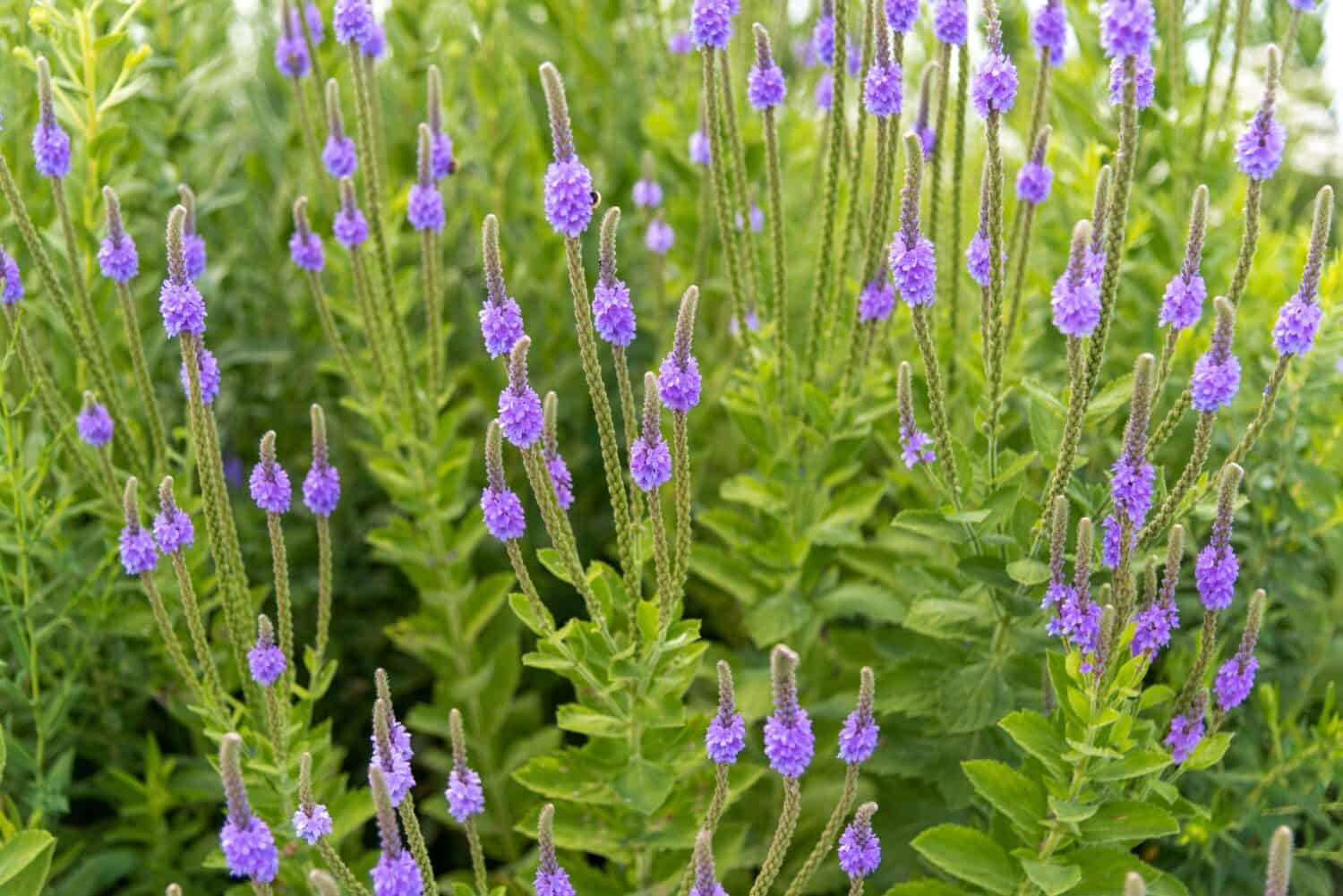
If you want to add a dash of purple color to your New York garden, the hoary vervain is a favorite perennial flower.
©Barbara Smits/Shutterstock.com
Hoary vervain is another perennial flower that thrives in New York. This plant features tall spikes of small bluish-purple flowers. These blooms appear from late spring all the way into fall, gradually opening from the base toward the top for a prolonged floral show. These nectar-rich flowers are a magnet for various pollinators, including butterflies and hummingbirds.
This plant makes a wonderful addition to gardens designed to attract wildlife or butterflies.
Hoary vervain typically grows to a height of 2 to 4 feet and spreads out to a width of 18 to 24 inches. It’s best to plant hoary vervain in a sunny location. The soil should be well-draining and can range from dry to moderately moist. This flower is commonly mistaken for a similar flower, the blue vervain. The easiest way to tell these flowers apart is that the blue vervain has much smaller flowers.
8. Painted Trillium (Trillium undulatum)
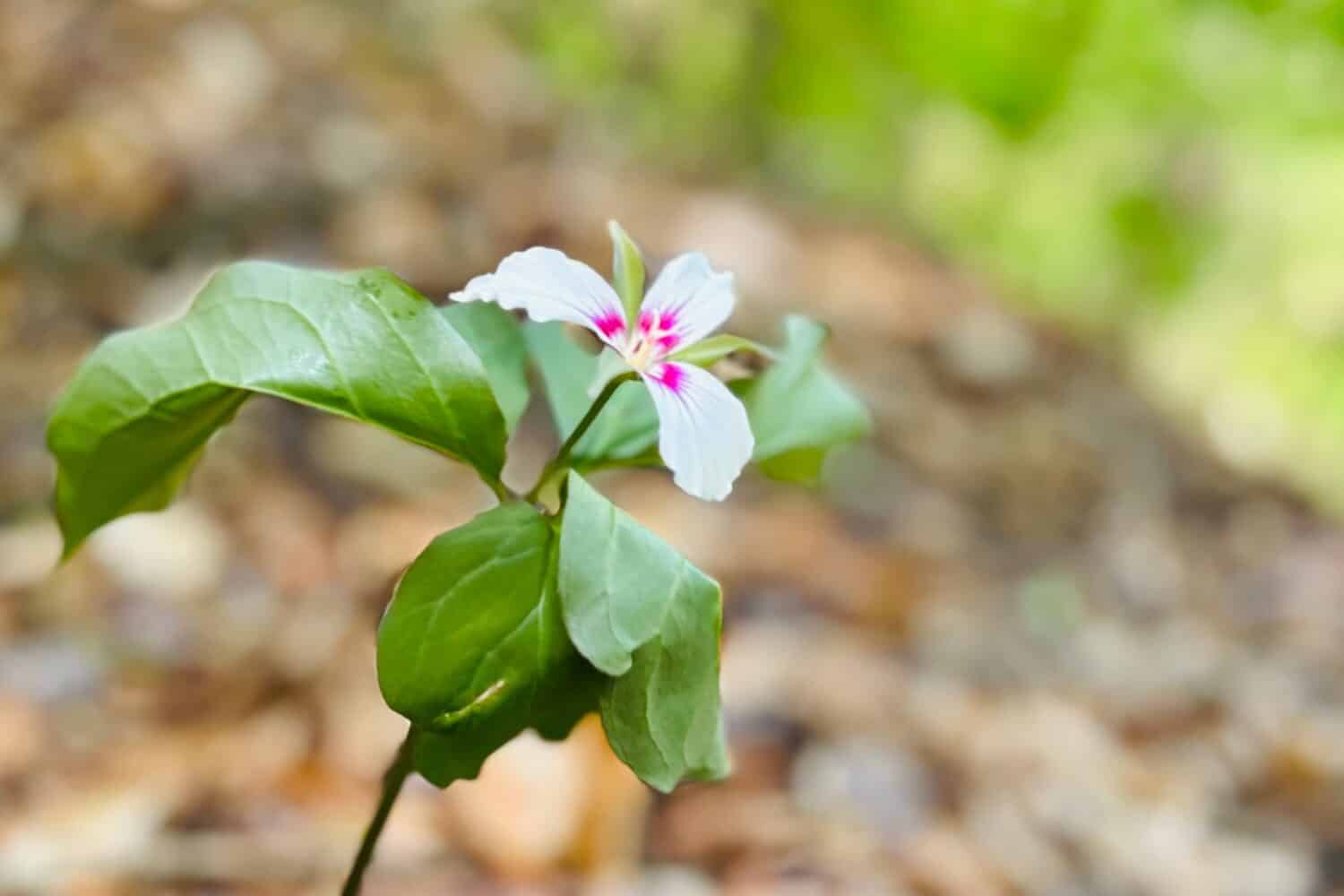
Painted trillium is a gorgeous wildflower that you can also plant in your home garden.
©wanderpix/Shutterstock.com
A beautiful flower that grows exquisitely in New York is the painted trillium. This flower features a unique arrangement of three oval-shaped, blue-green leaves at its base. During mid-spring to early summer, this plant showcases stunning white blossoms, each about 2 inches wide, with a hint of pink.
This easy-to-care-for trillium is a delightful option for New York gardens that focus on wildflowers or those with a forested setting. Over time, it tends to spread, creating a visually appealing ground cover.
The painted trillium can grow anywhere from 8 to 18 inches tall and spreads out to about 12 inches in width. For optimal growth, plant it in a spot with partial to full shade. The soil should be rich in organic matter, adequately moist, and well-draining, with an acidity level ranging from neutral to slightly acidic.
9. Virginia Spiderwort (Tradescantia virginiana)

These purple perennial flowers will spice up the color of your New York flower bed.
©Nikolay Kurzenko/Shutterstock.com
Virginia spiderwort is a robust perennial that forms clumps of bright green, slender leaves. These leaves can either stand upright or curve slightly. From late spring until midsummer, the tops of these leaves become a stage for small groups of violet-blue to purple flowers. Each flower has three petals and eye-catching yellow centers. While individual flowers may last for just a day, the plant produces so many buds that it practically stays in bloom all season long.
Be aware that this plant has a tendency to spread its seeds quite freely, especially when it’s happy with its growing conditions. So, it is more than likely that you will find more Virginia spiderwort plants popping up over the years.
As for its size, the Virginia spiderwort can reach a height of 18 to 30 inches and a width of 12 to 18 inches. It flourishes in partially shaded areas and prefers soil that is fertile, well-draining, and has a moisture level ranging from dry to damp.
10. Foam Flower (Tiarella cordifolia)
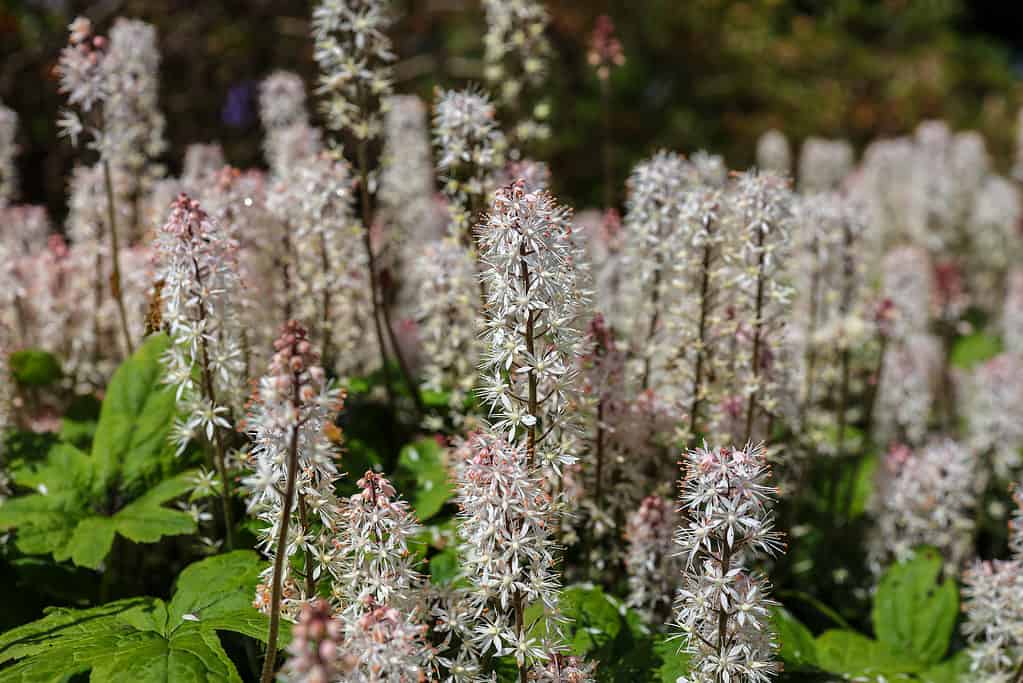
Foam flowers will add a lot of texture and color to any landscape.
©iStock.com/yujie chen
The foam flower is a perennial plant that is popular in many New York gardens. This flower grows from horizontal stems, creating a lush mound of shiny, heart-shaped leaves that are about 3 to 4 inches wide. These leaves are divided into 3 to 5 sections and show off a rich burgundy pattern along the veins, especially during spring and fall. In milder winters, the leaves can turn an all-over reddish-bronze color. During late spring, the plant produces white flowers with a pinkish hue on 3 to 4-inch long stalks.
This plant has earned recognition for its garden performance. Additionally, it makes an excellent ground cover, especially in areas with a lot of shade.
In terms of size, the foam flower grows to a height of around 12 inches and can spread 12 to 24 inches wide. Plant it in a spot with partial to full shade and make sure the soil is cool, rich in organic matter, well-drained, and stays relatively moist.
11. Crooked Aster (Symphyotrichum prenanthoides)
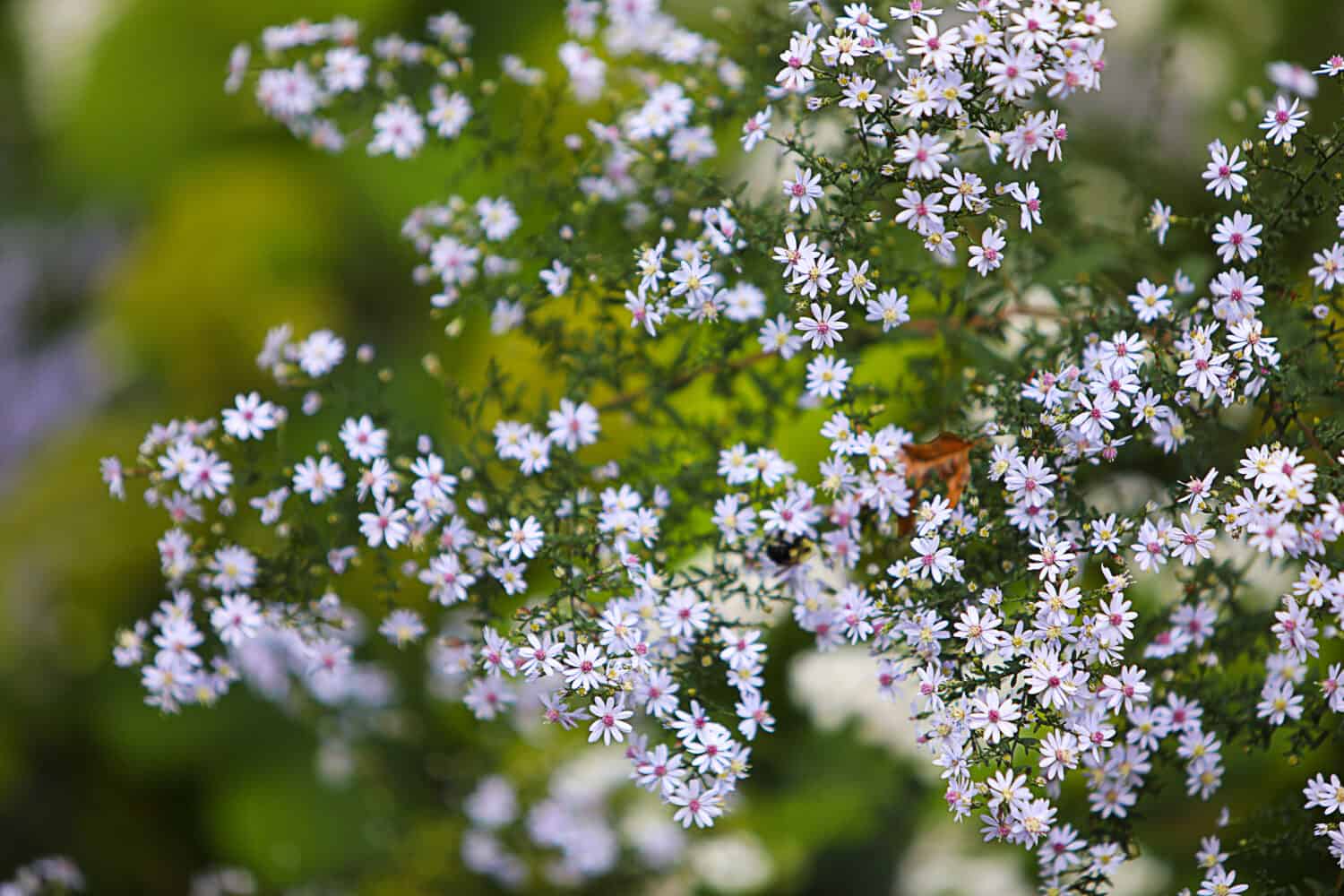
Another beautiful perennial flower is the crooked aster, which can contain up to 30 petals on a single flower!
©yakonstant/Shutterstock.com
Crooked aster is a perennial plant that flourishes in New York. The plant displays a profusion of delicate light blue to almost lavender flowers from late summer into fall. The plant features sturdy, highly branched stems that give rise to these petite, star-shaped flowers. Each flower consists of 20 to 35 white petal-like rays encircling a center filled with tiny yellow flowers. Eventually, as they age, the flowers turn reddish.
This flower is an excellent fit for gardens designed with native plants in mind. It also can potentially spread and form larger groups through its underground stems, known as rhizomes.
In terms of size, this plant can reach heights between 1 and 4 feet. It performs well in areas that receive full sun to partial shade and prefers soil that is moderately moist and well-draining.
12. Rough Goldenrod (Solidago rugosa)
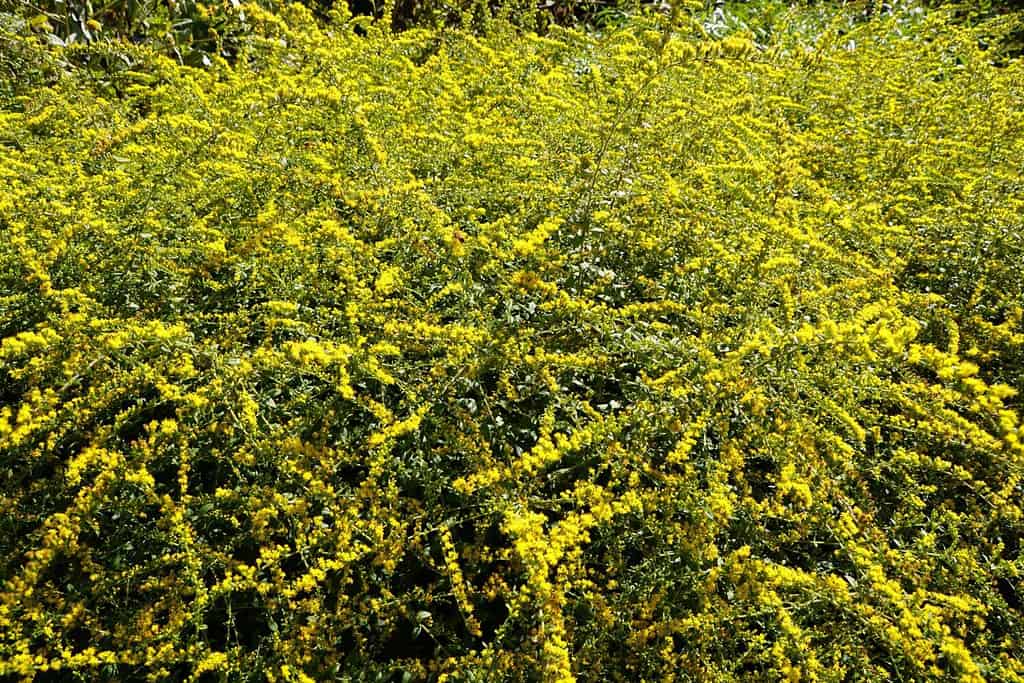
Creating an extraordinary sea of yellow, rough goldenrod is a striking perennial to plant in your garden.
©Khairil Azhar Junos/Shutterstock.com
Rough goldenrod forms a tight cluster, sprouting bright yellow blooms that arch outward from late summer to fall. Not just pretty to look at, these flowers are a magnet for 115 different kinds of insects, such as small bees, wasps, and even tiny butterflies.
If you’re looking for an easy-to-care-for plant that doesn’t demand too much attention, this one fits the bill. It’s an excellent option for sun-drenched borders or open spaces where it has room to spread.
This plant can grow between 3 and 5 feet both in height and width. It does well in full sunlight to partial shade and prefers soil that is somewhat acidic and well-draining while maintaining moderate to high moisture levels.
13. Needletip Blue-Eyed Grass (Sisyrinchium mucronatum)
Needletip blue-eyed grass is a perennial plant known for its bushy clump of thin, grass-like leaves. It sprouts light to dark blue star-shaped flowers that have uniquely pointed tips on their petals. These flowers, usually blossoming one at a time, appear in small groups of two to four atop skinny stalks from spring through summer.
Originally found in Canada and the southeastern U.S., this plant is a natural fit for meadows, beaches, and woodland borders.
Size-wise, it can grow anywhere from 6 to 18 inches in height and spread about 6 to 8 inches across. For best results, plant it in a spot that gets full sun or partial shade and has soil that retains moisture yet drains well.
14. Cup Plant (Silphium perfoliatum)
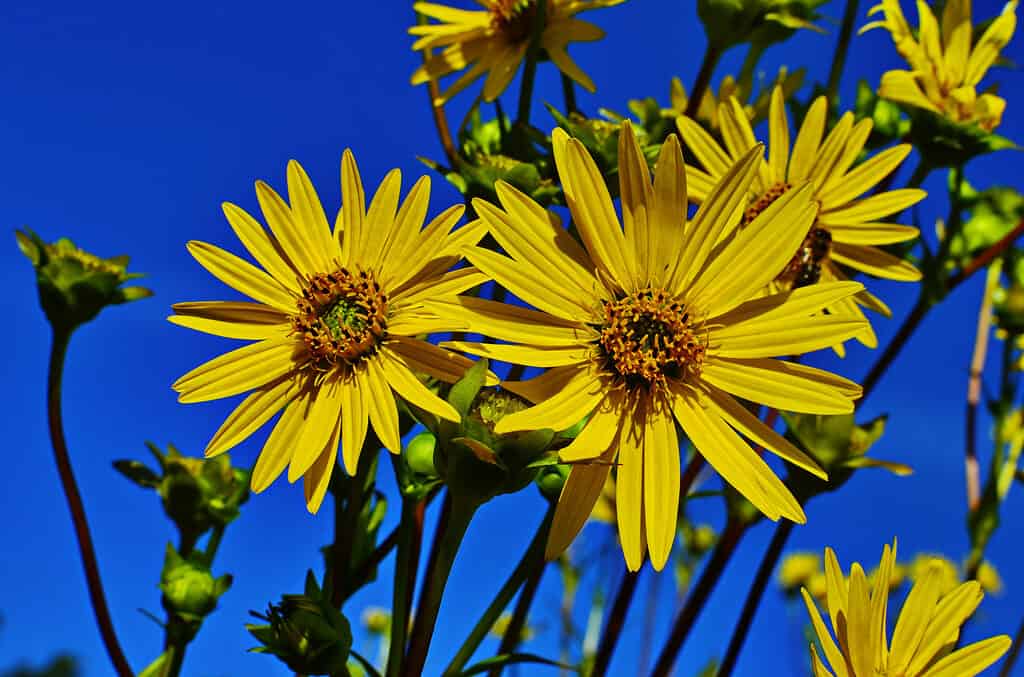
Resembling a sunflower, the cup plant produces large yellow flowers
©weha/Shutterstock.com
The cup plant is a perennial with a unique structure. Its strong, square-shaped stems are adorned with oval leaves that join at the stem, forming a small cup that stores water and attracts birds. During midsummer to early fall, you’ll see clusters of vivid yellow daisies, each about 3 inches wide, with a darker yellow center.
This eye-catching plant works well at the back of garden borders and is also an excellent fit for natural landscapes like prairies.
It can reach heights between 4 to 8 feet and spread out 1 to 3 feet. This plant thrives best in sunny locations with soil that’s well-drained but stays moderately to slightly wet.
Fun fact: The cup plant is referred to as a “cup” because its leaves can hold water. These large leaves collect dew and rainwater to nurture the plant.
15. Sweet Coneflower (Rudbeckia subtomentosa)
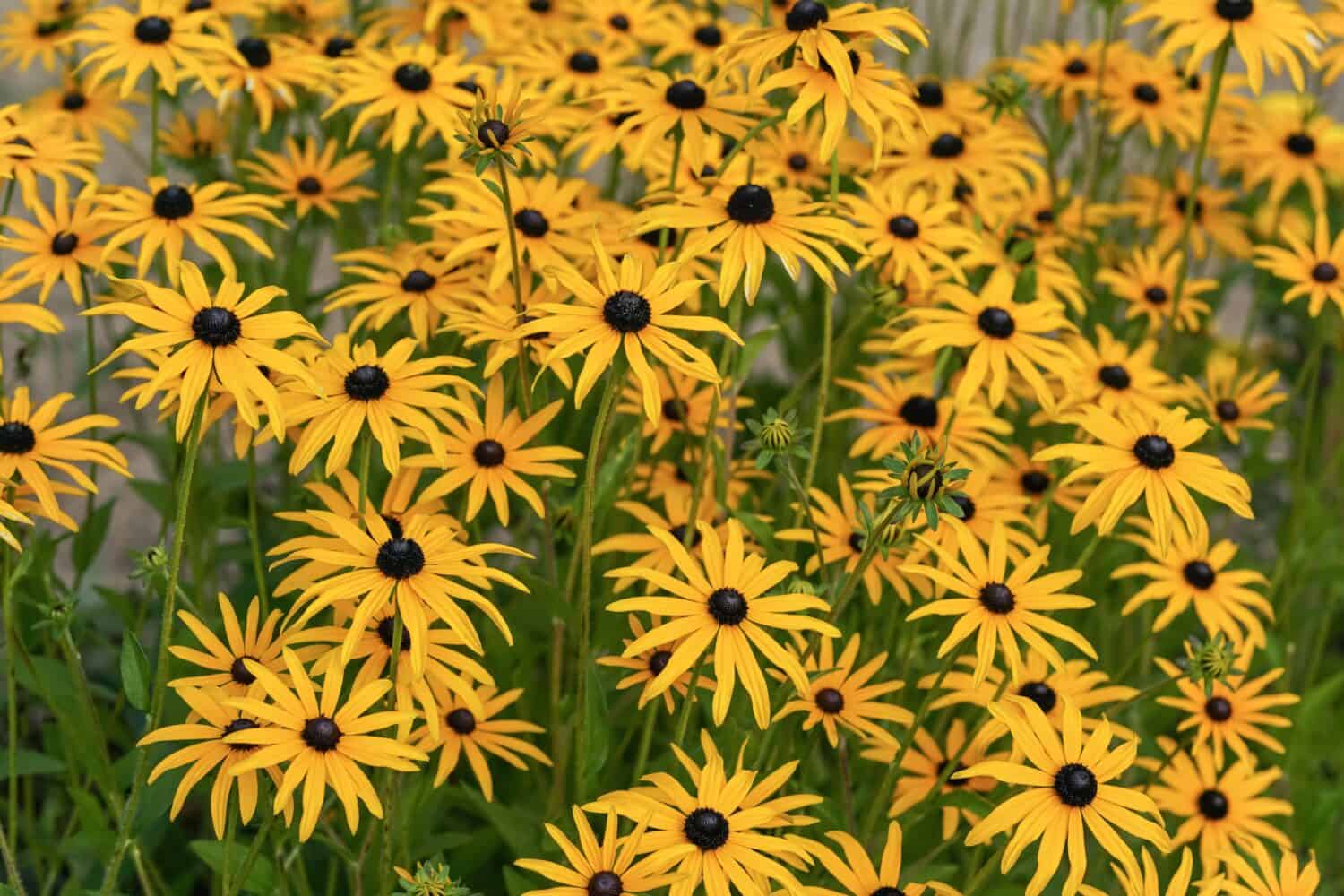
With an amazing, strong scent and a vibrant yellow color, sweet coneflowers are a wonderful addition to any garden.
©Lubo Ivanko/Shutterstock.com
The sweet coneflower is a hardy perennial that forms clusters and features numerous yellow daisy-like blooms, each around 2 to 3 inches wide, with dark brown centers. These flowers appear from the middle of summer until the first frost, growing on branching stems and releasing a delightful anise-like scent.
In New York, this plant tends to last longer in gardens compared to its relatives, the black-eyed Susan and brown-eyed Susan.
This flower can grow to heights between 3 to 6 feet and spreads out to 2 to 3 feet. It performs best when planted in sunny spots with well-drained soil that is moderately moist.
16. Virginia Rose (Rosa virginiana)

This unique purple flower is known as the Virginia rose and is a common sight in the eastern USA.
©iStock.com/Vincent Ryan
The Virginia rose is a quickly growing and winter-resilient shrub that stands upright. Its leaves are a rich green that transforms into a stunning orange-red during autumn. During summertime, it bursts into a lavish display of pink blossoms, each about three inches wide and pleasantly aromatic.
With an ability to thrive in various soil conditions and a knack for low maintenance, this shrub is a charming pick for gardens near the ocean or for attracting wildlife.
This plant can grow to heights between 4 to 6 feet and can spread as wide as 6 to 8 feet. It is best suited for places with abundant sunlight or partial shade and can thrive even in less-than-ideal soil conditions.
Fun fact: The Virginia rose is native to the eastern parts of the US and in the wild, this plant can grow to over 3 feet tall!
Summary of the Best Perennial Flowers for New York
| Flower | USDA Hardiness Zone |
|---|---|
| Golden Alexander | 3-8 |
| Adam’s Needle | 4-11 |
| Long Spurred Violet | 3-8 |
| Canadian Violet | 3-8 |
| New York Ironweed | 5-9 |
| Wingstem | 4-8 |
| Hoary Vervain | 4-7 |
| Painted Trillium | 4-8 |
| Virginia Spiderwort | 4-9 |
| Foam Flower | 3-8 |
| Crooked Aster | 4-7 |
| Rough Goldenrod | 4-8 |
| Needletip Blue-Eyed Grass | 3-8 |
| Cup Plant | 3-9 |
| Sweet Coneflower | 3-8 |
| Virginia Rose | 3-8 |
The photo featured at the top of this post is © Lubo Ivanko/Shutterstock.com
Thank you for reading! Have some feedback for us? Contact the AZ Animals editorial team.







